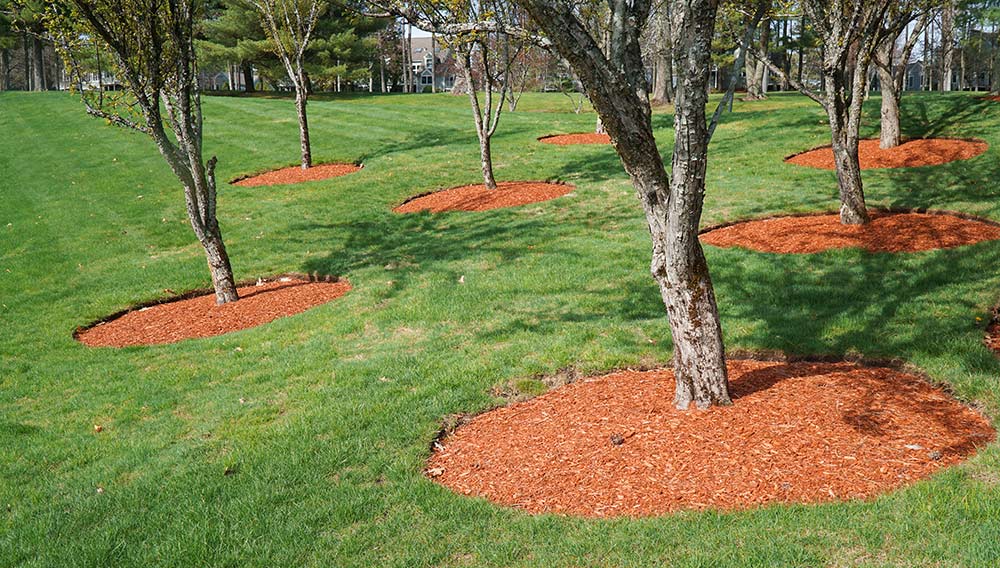Learn why mulching is so important for tree health and how to do it
With the warmer weather and lack of rain, California residents are doing everything they can to conserve water. Though they may not require daily attention, routine care is essential to ensuring the health, beauty, and safety of the trees on your property, especially in times of drought.
So how do you keep your trees healthy and irrigated while conserving water at the same time?
One of the best methods of supporting the health of your mature trees and saplings while conserving water is to use mulch. Mulching isn’t difficult, and this protective ground covering not only saves water, but it can also control weeds, enrich your soil, and more. The miracle of mulch!
With the steps outlined below, you’ll learn how to mulch trees, how much mulch to use, and the best type for your needs.
5 Ways Trees Benefit from Proper Mulching
First, let’s look at the big picture and the specific benefits mulch provides for your trees. Knowing how mulch works can help to focus your efforts and maximize the benefits.
1) Retain moisture in the soil
Mulching your trees provides an insulating blanket over the soil to reduce evaporation, retaining the precious moisture for the tree’s roots. This is especially important when you’re keeping an eye on your water use during a drought.
Mulch also suppresses the growth of weeds and grasses, so the tree roots don’t have to compete with invasive plants for water. When the rains come, the mulch will then aid in preventing the loss of water via run-off and erosion.
2) Moderate soil temperature
With the correct amount of mulch, you can also moderate soil temperature fluctuations. During hot weather, mulches keep the ground from being exposed to the sun and heat, keeping the soil cool. This protects the top soil from drying out and hardening around the tree roots.
During cold weather, mulches help the soil retain warmth, reducing the chance of frost damage or root injury.
3) Improve soil health
When organic mulch decomposes, it provides structure, nutrients, and aeration for the soil. More information regarding organic vs inorganic is discussed in the next section.
4) Provide Protection
When mulch is distributed properly, it also protects the roots, helps keep the trunk dry, and helps prevent soil compaction from foot traffic and lawn mowers.
5) Discourage weed and grass growth
As mentioned earlier, mulching discourages weed and grass growth. When weeds and grasses grow at the base of a tree, these uninvited plants steal not just the moisture from the soil, but also the nutrients that the tree needs.
Proper Mulching for Trees
Organic vs Inorganic
When it comes to choosing the best type of mulch for your landscape, you generally have two options: Organic and inorganic. Both types have their own unique benefits and disadvantages.
Organic Mulch
If you don’t mind a bit more routine care and want to boost the health of your topsoil, organic mulch is the way to go.
Types of organic mulch include:
- Wood chips
- Straw
- Pine needles
- Shredded hardwood or softwood
- Bark
- Leaves
As we mentioned earlier, organic mulches improve the soil structure and increase soil fertility when they decompose. However, because they do break down over time, organic mulch can require a bit more upkeep and reapplication.
Inorganic Mulch
If you would prefer a more eye-catching and low-maintenance option, inorganic mulch might be right for you.
Types of inorganic mulch include:
- Stones or pebbles
- Gravel
- Tarp
- Rubber
While inorganic mulches don’t provide the same soil-enriching benefits, they do provide longer-lasting weed prevention that requires less upkeep.
Aesthetically, inorganic mulches can also be more versatile. River rocks or other multicolored stones are great mulch options that can be a gorgeous addition to your landscape.
Mulch to the drip line
When applying mulch, it’s important to know the scope of the area you are covering and how close to get to the trunk. Mulch should be kept away from the trunk and begin at the “root flare.” This is the area where the roots flare out, above ground, at the base of the tree.
The circumference of the mulch area should increase as the tree grows. Ideally, the mulch should extend as far as the tree’s canopy, also known as the “drip line.”
Avoid over mulching
The most common mulching mistake is over-mulching. Piling mulch over the root flare and up the trunk is not recommended. In addition, the depth of mulch should be between two and four inches, or less if the soil is poorly drained.
Finer or dense mulch such as pebbles, should typically only be piled one to two inches deep, to ensure enough oxygen and water is able to reach the root system.
The Arborists at Vintage Tree Care are here to help
You now know all the ways mulching can benefit the health of your trees and save water. We have also covered the proper method, materials, and frequency. Now, it’s time to give those trees a good mulching.
If you have a tree that has already been over-mulched or are worried about the general health of your newly planted or mature trees, a certified arborist can help. If your trees are showing signs of distress, contact us by phone at (707) 495-4686 or online to schedule an arborist inspection.


